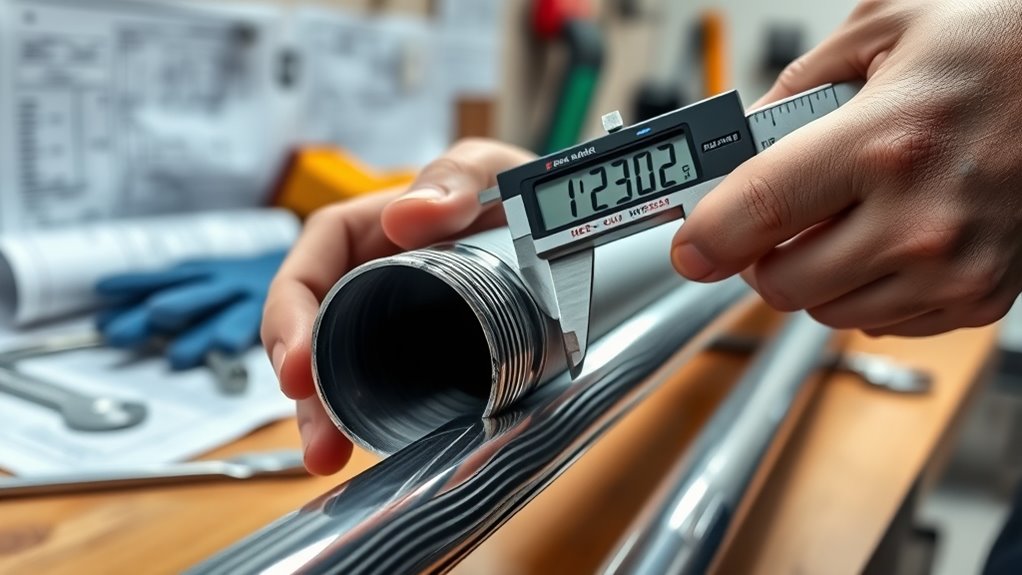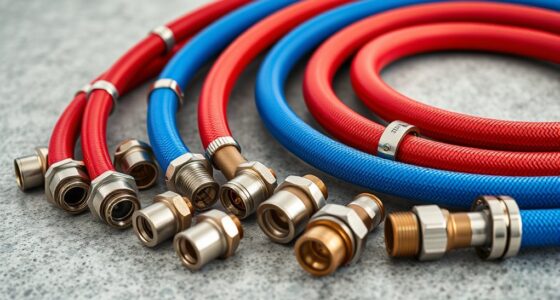Choosing the right natural gas line size is essential for safety, efficiency, and compliance. You need to take into account gas pressure, flow rate requirements, and the distance from your meter. Material choice also matters, along with following industry standards like NFPA 54. If you’re unsure when to seek professional help or how to calculate pipe size, keep exploring to ensure your system works safely and effectively.
Key Takeaways
- Proper gas line sizing ensures safety, efficiency, and compliance with standards like NFPA 54 and UL.
- Consider pressure, flow rate, and distance from the gas meter when selecting pipe size.
- Convert appliance BTU ratings to cubic feet per hour to determine required flow capacity.
- Use appropriate materials such as steel, copper, or approved plastics, considering corrosion resistance and safety.
- Always consult licensed professionals for installation, safety checks, and adherence to local codes.
What Is the Purpose of Determining the Right Gas Line Size?
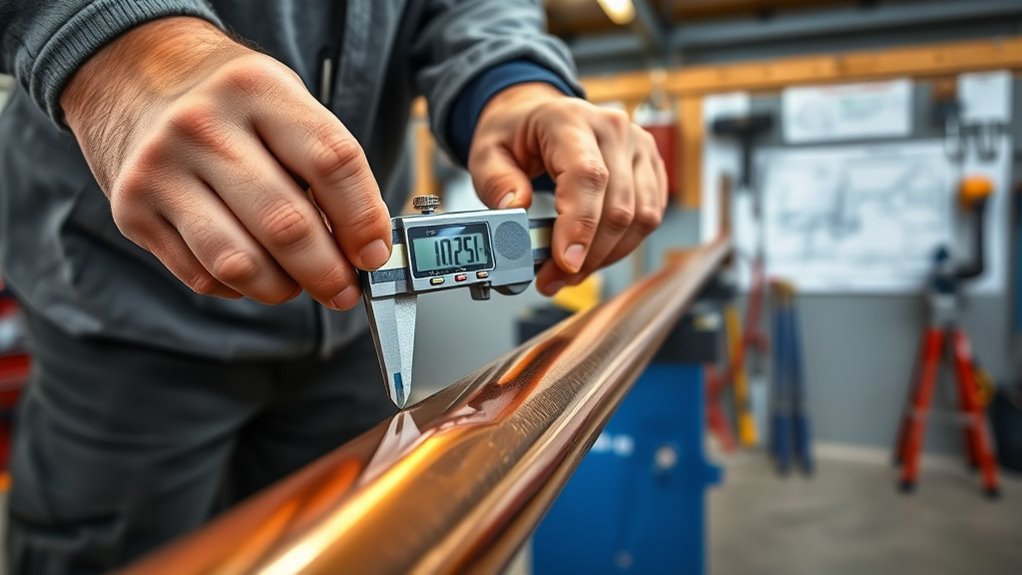
Have you ever wondered why choosing the correct gas line size matters? The primary purpose is to guarantee safe and efficient delivery of natural gas. An appropriately sized line prevents gas leak prevention issues, reducing the risk of dangerous leaks that could lead to accidents or health hazards. Proper sizing also guarantees the system operates within regulatory compliance standards, avoiding fines or legal issues. When the gas line is too narrow, it hampers flow and causes pressure drops, while an oversized line wastes resources and increases installation costs. Accurate sizing balances safety, efficiency, and cost-effectiveness. It helps you maintain a reliable gas supply and complies with safety regulations, giving you peace of mind that your system is both safe and compliant. Understanding proper sizing techniques is essential to ensure optimal performance and safety of your gas system.
How Does Gas Pressure Influence Line Sizing?
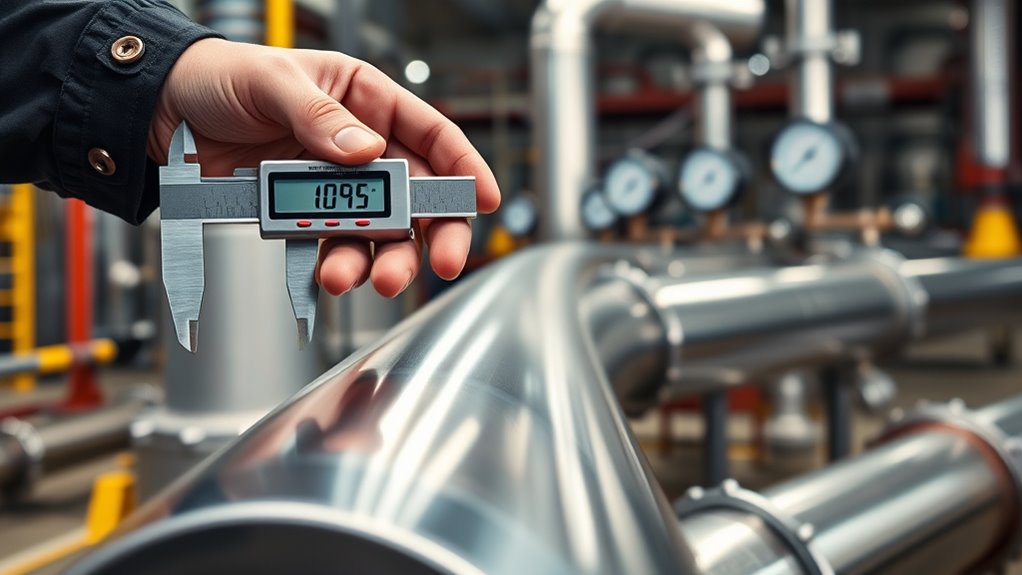
Gas pressure plays a crucial role in determining the appropriate size of your natural gas line because higher pressure can push more gas through a smaller diameter, while lower pressure requires a larger line to maintain adequate flow. If your gas pressure is high, you can often use a smaller pipe diameter without sacrificing flow rate. Conversely, low gas pressure means you’ll need a larger pipe to prevent pressure drops and ensure consistent delivery. To optimize line sizing, consider these factors:
- The relationship between gas pressure and pipe diameter to maintain flow.
- How pressure drops affect overall system efficiency.
- The importance of balancing pressure and pipe size for safety and performance.
- AI-driven analytics can assist in modeling the optimal line sizes based on pressure data and system requirements.
Understanding this interplay helps you select the right gas pressure and pipe diameter for your system’s needs.
What Factors Affect Natural Gas Flow Rate Requirements?
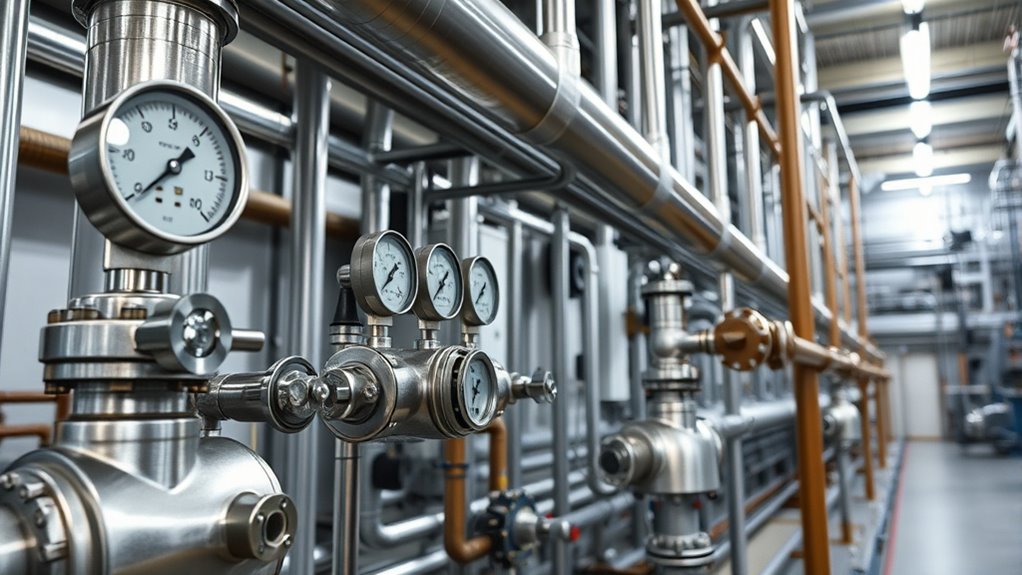
The factors influencing natural gas flow rate requirements directly impact how you size your piping system to meet your needs. Your gas flow depends on the amount of gas your appliances or equipment require during operation. Higher gas flow demands mean you’ll need a larger pipe capacity to guarantee efficient delivery without pressure drops. The type and number of appliances, their BTU ratings, and simultaneous usage all affect flow rate needs. Additionally, the distance from the gas source influences flow requirements, as longer runs can reduce pressure and require increased pipe capacity. Proper understanding of heat pump efficiency ratings can also be useful when evaluating overall energy needs for your system. By understanding these factors, you can accurately determine the necessary flow rate, helping you select the right pipe size to ensure safety, efficiency, and proper gas delivery for your setup.
How Do I Calculate the Appropriate Pipe Diameter for My Project?
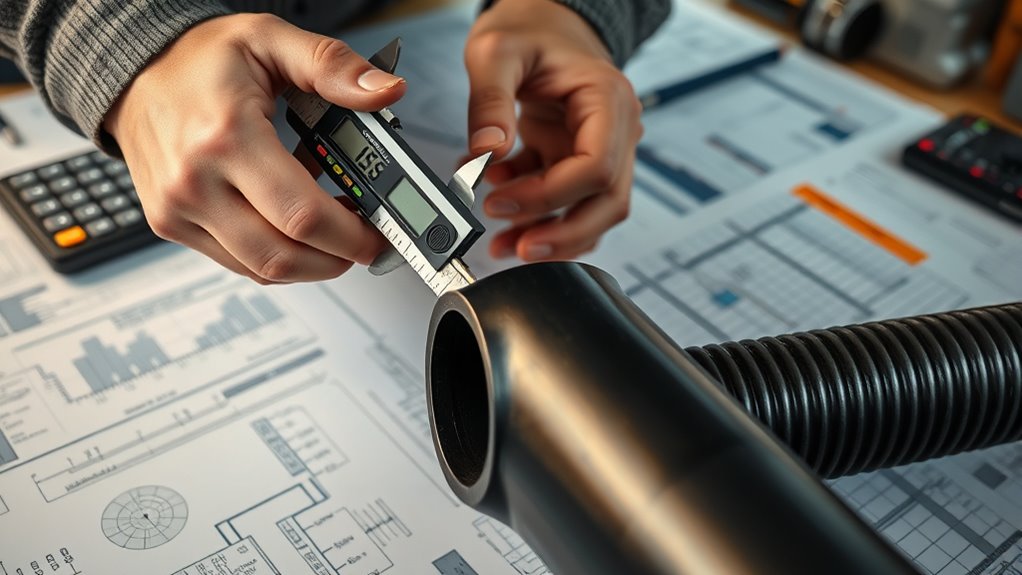
To find the right pipe diameter, start by determining your gas flow rate requirements based on your project’s needs. Then, use appropriate pipe sizing formulas to match the flow rate with the correct pipe size. This process guarantees your system operates safely and efficiently. Additionally, considering performance upgrades can help optimize system performance and reliability.
Determine Gas Flow Rate
Calculating the correct pipe diameter starts with determining your project’s gas flow rate. This step guarantees you select the right size for efficiency and safety. To do this:
- Identify your appliance’s BTU requirements and convert them to cubic feet per hour.
- Consider pipe material selection, as different materials have varying flow capacities.
- Consult safety inspection guidelines to account for maximum allowable flow rates and pressure drops.
Accurate flow rate measurement helps prevent under-sizing or over-sizing your pipe, which can compromise safety or performance. Remember, proper calculation isn’t just about capacity; it also influences the overall safety inspection process. Knowing your flow rate allows you to choose the right pipe diameter, ensuring your installation is safe, efficient, and compliant with regulations.
Apply Pipe Sizing Formulas
Once you’ve determined your gas flow rate, applying the right pipe sizing formulas guarantees you select a diameter that maintains proper flow and safety. To do this, perform a flow calculation that considers your gas pressure, flow rate, and pipe length. Use standard formulas or charts to relate flow velocity, pressure drop, and pipe diameter. These calculations help you find the ideal pipe diameter, ensuring your system runs efficiently without excessive pressure loss. Remember, an undersized pipe can cause dangerous pressure drops, while an oversized pipe may be unnecessarily costly. Always double-check your calculations and consult relevant codes or standards. Accurate pressure drop calculations are essential for proper sizing. Applying these formulas accurately ensures your natural gas line is properly sized, promoting safety and reliable operation throughout your project.
What Safety Considerations Should I Keep in Mind When Selecting a Gas Line?

When choosing a gas line, make sure you select the proper materials that are rated for natural gas and meet safety standards. You also need to guarantee your space has adequate ventilation to prevent gas buildup. Ensuring your installation includes proper safety features is essential for protecting you and ensuring your system operates reliably.
Proper Material Selection
Choosing the right material for your gas line is essential for safety and durability. You want a material with excellent corrosion resistance and high material durability to prevent leaks and failures. Incorporate materials like copper or stainless steel that are known for their sound healing science to withstand moisture and soil conditions. Consider these factors: 1. Use corrosion-resistant materials like copper or stainless steel to withstand moisture and soil conditions. 2. Prioritize durable options that resist wear and damage over time, ensuring long-term safety. 3. Check local codes for material approval and compatibility with natural gas to avoid potential hazards. Selecting the proper material minimizes risks of leaks, explosions, or deterioration. It also ensures your gas line remains reliable under various environmental conditions. Focusing on corrosion resistance and durability guarantees your installation is safe, effective, and compliant.
Adequate Ventilation Measures
Ensuring proper ventilation is crucial for safety when selecting a gas line, as inadequate airflow can lead to the buildup of dangerous gases in enclosed spaces. Ventilation safety isn’t just about opening windows; it requires understanding airflow requirements for your specific setup. You need enough airflow to disperse any leaks or emissions, reducing the risk of gas accumulation. Proper ventilation measures include installing vent hoods, exhaust fans, or vents that promote continuous airflow. Always position gas appliances and lines away from confined areas and guarantee ventilation systems are functioning correctly. Regular inspections are essential to verify that airflow remains sufficient. Incorporating AI-driven safety monitoring can further enhance ventilation effectiveness by providing real-time alerts for airflow issues. By prioritizing ventilation safety, you minimize hazards and ensure your natural gas system operates securely.
Are There Industry Standards or Codes I Need to Follow?
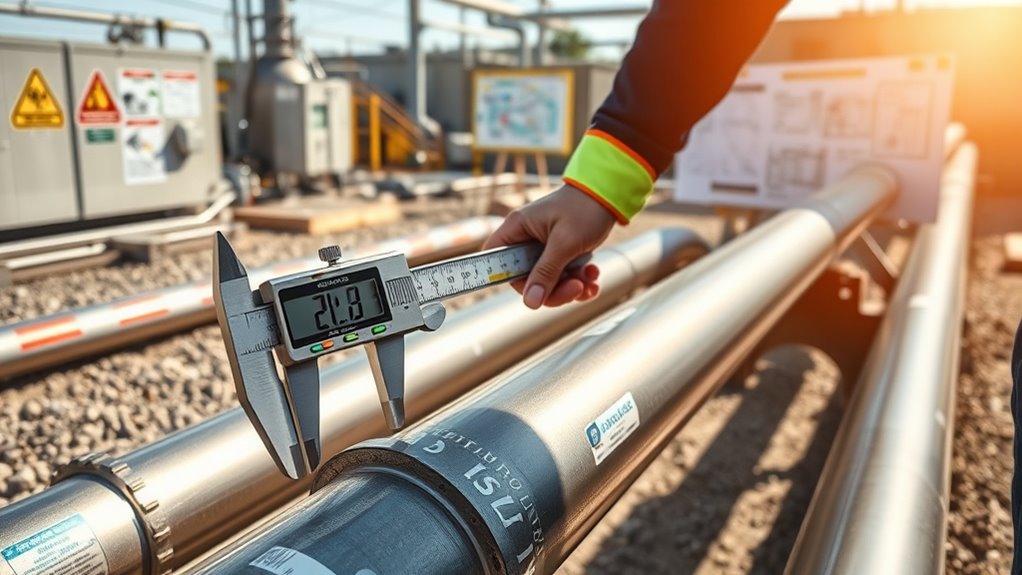
You must follow specific industry standards and codes to guarantee your natural gas line is safe and compliant. These standards ensure proper installation, safety, and efficiency. To adhere to code compliance, consider these key points:
- Refer to local building codes and regulations, such as the National Fuel Gas Code (NFPA 54) or local amendments.
- Use materials and fittings approved by recognized organizations like ASTM or UL.
- Consult with licensed professionals to verify your design meets all safety and regulatory requirements.
- Be aware of regulatory transparency and the importance of staying informed about updates to standards and codes.
Following these industry standards not only ensures safety but also helps you avoid costly mistakes or legal issues. Always stay updated on code revisions, and prioritize code compliance for a reliable, safe natural gas line installation.
How Does the Distance From the Gas Meter Impact Line Sizing?

The distance from the gas meter directly affects the required size of your natural gas line, as longer runs increase pressure loss and reduce flow capacity. Proper gas meter placement and pipeline routing are essential to minimize these effects. If your pipeline is longer, you’ll need a larger diameter pipe to maintain adequate gas flow. Here’s how distance impacts sizing:
| Distance (feet) | Pipe Diameter Needed | Typical Use Case |
|---|---|---|
| Less than 50 | Smaller, ½ inch | Short runs, small appliances |
| 50-150 | Medium, ¾ inch | Moderate distances |
| Over 150 | Larger, 1 inch or more | Long pipeline runs |
Proper planning ensures your gas line provides sufficient capacity without unnecessary expense. Additionally, understanding home improvement principles can help optimize the entire setup to ensure safety and efficiency.
What Materials Are Commonly Used for Natural Gas Pipes?

Natural gas pipes are made from a variety of materials designed to guarantee safety, durability, and efficient flow. When choosing materials, you should consider factors like pipe corrosion and material compatibility to prevent leaks or failures. Common options include:
- Steel: Known for strength and durability, but it requires protective coatings to prevent pipe corrosion.
- Copper: Offers excellent material compatibility and corrosion resistance, making it suitable for many installations.
- Plastic (such as PE or PVC): Lightweight and corrosion-resistant, but ensure proper material selection to avoid issues with pipe corrosion or incompatible fittings.
Each material has its benefits and limitations, so understanding how pipe corrosion and material compatibility affect performance helps you make informed decisions for safe, long-lasting gas lines.
When Should I Consult a Professional for Gas Line Installation?
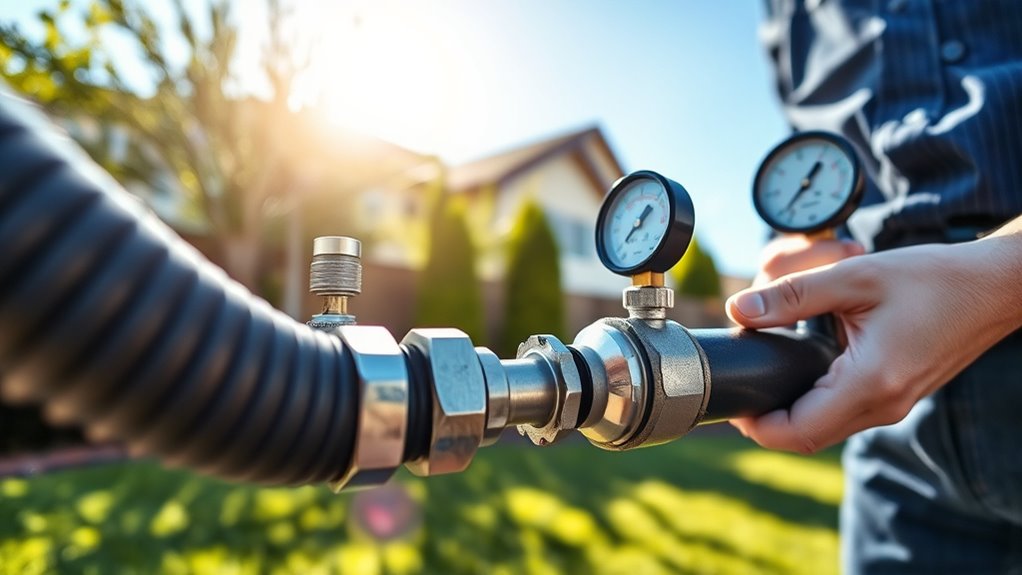
While installing a gas line might seem straightforward, it’s vital to know when to call in a professional to guarantee safety and code compliance. If you notice signs of a gas leak, such as a rotten egg smell or hissing sounds, stop and consult an expert immediately. Professionals also guarantee proper gas leak prevention and set up maintenance schedules to keep your system safe over time. Consider hiring a pro if you’re unsure about pipe sizing, local regulations, or venting requirements.
| When to Call a Professional | Why It Matters | What They Handle |
|---|---|---|
| Gas leak signs | Prevent accidents | Leak detection, repairs |
| Complex system installation | Safety & code compliance | Proper sizing & connections |
| Routine maintenance | Long-term safety | Inspections, maintenance schedules |
| Uncertain about regulations | Legal compliance | Permits, inspections |
Frequently Asked Questions
Can Flexible Pipes Be Used for Natural Gas Line Installations?
Yes, flexible piping can be used for natural gas line installations, but you must guarantee it meets strict safety standards. Flexible piping offers ease of installation and adaptability, but it’s essential to use products specifically rated for gas safety. Always follow local codes and manufacturer instructions, and have a professional inspect your setup. Properly installed flexible piping helps prevent leaks and ensures safe, efficient operation of your natural gas system.
How Often Should Gas Lines Be Inspected or Maintained?
Think of your gas line like a garden hose; regular inspection keeps it flowing smoothly. You should inspect your gas lines annually and perform maintenance whenever you notice signs of gas line corrosion or leaks. Routine inspections, ideally every 12 months, help catch issues early, preventing hazards. Staying proactive guarantees your gas lines remain safe, reliable, and free from corrosion or damage that could compromise your system’s integrity.
What Are Common Signs of Gas Line Leaks?
You should watch for signs like a rotten egg smell, hissing sounds, or dead vegetation near your gas lines. Gas leak detection is essential, so if you notice any of these, evacuate immediately and avoid using electrical switches. Always follow safety precautions by contacting professionals to inspect and repair the leak. Prompt action prevents accidents and keeps your home safe from potential hazards.
Are There Environmental Regulations Affecting Gas Line Installation?
Environmental regulations definitely influence gas line installation, and you need to stay compliant to avoid fines or delays. While safety is your top priority, you also must consider the environmental impact of your project. Regulatory compliance guarantees that your installation minimizes harm to the environment, balancing safety and sustainability. Ignoring these rules risks legal issues and environmental damage, so always check local codes and regulations before starting your gas line installation.
How Does Temperature Affect Natural Gas Flow and Line Sizing?
Temperature fluctuations cause natural gas to expand or contract, impacting its flow and the line size needed. As temperature rises, gas expands, reducing pressure and flow efficiency, so you might need a larger line to compensate. Conversely, cooler temperatures cause gas to contract, increasing pressure. Always consider gas expansion when sizing lines, especially in areas with significant temperature variations, to guarantee safe and efficient flow throughout the system.
Conclusion
Just as Icarus needed careful wings for his flight, you must choose the right gas line to guarantee safety and efficiency. By understanding the factors involved and following industry standards, you can navigate the complexities of natural gas line sizing confidently. Remember, even Daedalus sought expert guidance—so when in doubt, consult a professional. Your careful planning today keeps your project soaring smoothly, avoiding pitfalls and reaching new heights safely.
